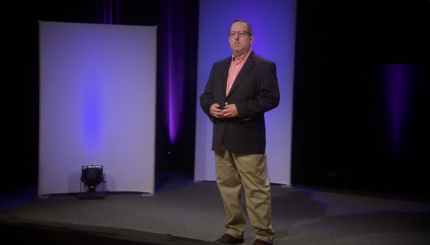Reprinted with permission from The Jewish Way (Touchstone).
The intense focus on death during the holiday period runs the risk of turning morbid. Since encounter with death evokes guilt, there is a risk that the High Holy Days will turn into a guilt trip; however, the goal of the Days of Awe is not merely repentance but renewal. It is a move toward an examined life, not masochistic self-flagellation.
It is not only physical death that threatens the humanness of life but a kind of death in life, a psychic numbing. Routinization, loss of responsiveness, and habituation deaden perception and concern. When we stop examining our lives, we lose the ability to give appropriate responses to the variety of experiences that life presents to us.
The Fullness of Life
One definition of life is the capacity to respond. The direction of life’s growth in the eyes of Jewish tradition is toward ever-greater responsiveness. Inorganic matter does not respond. The higher up the evolutionary scale, the greater the movement from biological necessity to psychic freedom. The goal of the human in God’s image is the fullness of life: to become more and more like God, Who responds out of the infinity of life, not in a pre-programmed fashion without necessity or determinism but uniquely and appropriately to each person and situation. The normal processes of routinization and numbing are the enemies of this growth.
With your help, My Jewish Learning can provide endless opportunities for learning, connection and discovery.
Ordinary consciousness selects and filters from reality to construct a “stable” reality and consciousness. Human sensory systems have evolved to tune out everyday patterns and to respond primarily to changes in the environment. As people learn, the skills they acquire often become automatic; many personal movements no longer enter consciousness. People learn to numb responses and conscience in the face of cruelty, injustice, and death because these are traumatic, psychic-overload experiences that cause pain. Thus, in the daily normal process of living, the psyche begins to die. Even intense positive experiences–such as love relationships–eventually become routine and familiar. How, then, can individuals stay alive, intensely alive, psychically alive?
The answer given by Jewish tradition is that one cannot avoid death or death-in-life. The only way to overcome death is by rebirth. In the face of physical death and annihilation, human beings respond with the re-creation of life, the birth of children. To psychic death human must respond with psychic rebirth. This is another goal of the High Holy Day season.
Change is Possible
The power of sin–and of bad patterns–is that it convinces people that change is impossible. People despair of their ability to change an give up the capacity to grow or renew. The promise of repentance an the model of God challenge this hopelessness. There is a process of rebirth, but it needs attention, effort, and help.
The first step is to become conscious of one’s life, to overcome the routines that block the capacity to evaluate, correct, and change. Setting aside time in Elul [the month preceding the High Holidays] or during the High Holy Days is the beginning of liberation. It is a time for families to sit down together, for single individuals and for husbands and wives alike to do an inventory and accounting of the year that has passed in their lives. It is a time to express dissatisfaction and to weigh or gather the resources for change. If there has been no time for introspection all year, then it must be found in this period.
Here is where the consciousness of death plays a vital role. The shock of death reminds us that time is short–too short–to waste, too short to let pride and despair trap one in a life pattern with little in it to savor or respect. The very awareness of mortality suddenly puts life into bold relief. No aspect of life can be taken for granted; no feature of one’s personal way is either eternal or absolutely necessary. Thus, one can review, fine-tune, or alter with a new consciousness of alternatives.
Re-Asserting Life
The most dramatic expression of this concept is on Yom Kippur day, when every possible occupation or distraction is suspended; even the life processes of eating and sexuality are stopped. It is as if all of life is stopped and now can be chosen anew.
The descent into death also energizes the life forces. Both the body and the psyche revolt against non-being by reasserting life. This is as true for community as it is for the psyche. It is no accident that the generation of the Holocaust is the same generation that established the State of Israel. Only those who have tasted degradation can fully savor the urgency of life and the goodness of dignity in this generation. And, like a blind person whose sight is restored, after the gloom of Yom Kippur people find the world a riot of color, an outburst of dazzling variety.
“The unexamined life is not worth living,” said Socrates. “To live the unexamined life is not really living” would be the Torah’s version. People stay alive by being reborn. When rebirth stops, the individual will soon be dead. If you are the same as you were last year, you have died a little in the interim.
The promise of divine help and the sustenance of a community of life that has been reborn repeatedly strengthen personal efforts to renew the self. In Jewish tradition, the concept of ritual impurity is identified with routinization. The ultimate impurity is death, which is the ultimate routine. Going to mikvah [the ritual bath] and the symbolic washing of hands are rituals that externalize the drive to be reborn. The Jewish tradition sees sin as the enemy of life. The despair of guilt is the evil force that tells people. they cannot change or that they cannot perfect the world. Therefore, repentance is the process of these weeks, but rebirth and renewal are the substance.
Sign up for a Journey Through Grief & Mourning: Whether you have lost a loved one recently or just want to learn the basics of Jewish mourning rituals, this 8-part email series will guide you through everything you need to know and help you feel supported and comforted at a difficult time.
Looking for a way to say Mourner’s Kaddish in a minyan? My Jewish Learning’s daily online minyan gives mourners and others an opportunity to say Kaddish in community and learn from leading rabbis.
Elul
Pronounced: eh-LULE, Origin: Hebrew, Jewish month usually coinciding with August-September.
Yom Kippur
Pronounced: yohm KIPP-er, also yohm kee-PORE, Origin: Hebrew, The Day of Atonement, the holiest day on the Jewish calendar and, with Rosh Hashanah, one of the High Holidays.


